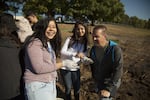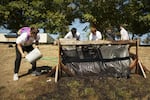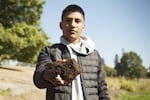The ground behind Woodburn High School in Oregon is full of bones — bones that are more than 10,000 years old.
Tucked between a school, a bypass, a thoroughfare and train tracks, this mid-Willamette Valley spot is an unexpected place to find one of the richest paleolithic sites in North America, called the La Brea of the Northwest by those familiar with its treasures.
Even within within the Northwest, it’s something of a paleontological secret. When most people here think prehistoric animals, they think of the better-known John Day Fossil Beds in remote Eastern Oregon.
Unlike the bones in John Day, these aren’t fossils, they’re truly bones, preserved in an oxygen-free layer of muck that stops them from decomposing or fully fossilizing. Scientists can, and have, extracted DNA from those bones.
Ten thousand years ago the valley here was mostly wetland. Animals entered the bog, lived their lives there, and after they died, they sank. They lay covered with water and muck until construction crews laying sewer lines or building bypasses dug them up.
Bill Orr, a paleontologist and professor emeritus at the University of Oregon was one of the first to study the site. He told OPB in an email that he sent one of his “minions” down to look at the excavation. “Sure enough, workers had collected several large bones and stowed them in the back of their pickup. My student went along and pulled them out with little fanfare.”

David Ellingsen (right) looks at bones his students brought to him.
Erin Ross / OPB
Now, the bones are seeing the light of day again. Woodburn High School science teacher David Ellingsen coordinates twice-yearly digs at the site with financial support from the city. He helps citizen scientists, members of the community and his students dig the bones up. It’s a rare opportunity for anyone with an interest in science to try hands-on paleontology.
Ellingsen’s classroom is full of specimens excavated by previous classes. They’re meticulously labeled and stored in jewelry boxes and petri dishes, display cases full of muskrat mandibles, frog femurs and beaver bones.
The school is being renovated for the summer, so his display cases full of bones — Ellingsen said there are 2,000 to 3,000 — are draped in protective plastic curtains. They rustled as he pushed them to the side, pulling out tray after tray of bones to show visitors from the North American Research Group, called NARG. (And yes, they want you to pronounce it like “ARGH!” with an N at the beginning.)
“Do you see these?” Ellingsen held up a vial of translucent slivers suspended in water. “They’re 10,000-year-old fish spines! From stickleback fish!”

Woodburn High School science teacher David Ellingsen points out a small bone excavated earlier in the day. The ancient bones are stored in bags of water to preserve them.
Erin Ross/OPB
At the front of Ellingsen’s classroom stands Woodburn High School’s pride and joy: a massive, ancient bison skeleton. The skeleton was excavated entirely by Woodburn students, and assembled by one, Odulia Flores, as her senior project. She got to present the research at a meeting of the Geological Society of America.
It’s much larger than the bison that roam parts of the U.S. today. At shoulder height, it’s almost as tall as Ellingsen.
Ellingson leads two excavations every year. The first is in August and is open to the public. The second excavation, in September, is just for the students. The freshmen put plastic bags over their feet to protect brand-new shoes and make their way behind the school, where a backhoe has just finished digging.
Finding bones takes patience and a good dose of luck. The students gather around a pile of excavated dirt and begin to sift through. Some patiently carve off slices of compacted dirt with a trowel, hoping to strike gold. Others just crumble the blocks with their hands. A few carry buckets of dirt over to a screening station, where wooden-framed window screens sit on two legs. One student sprays the clods with water while another rubs it against the screen with their hands. The mud falls through the screens and the bones remain.

Woodburn High School students filter buckets of dirt with a hose and screens. They're looking for tiny bones from ancient frogs, muskrats and beavers.
Erin Ross/OPB
If the students spray each other a little, well, it’s a hot September day, and no one seems to mind.
If someone finds a bone, they take it to Ellingsen. Sometimes it’s a false alarm and just a piece of wood. It can be hard to tell what something is, when it’s the size of a piece of pencil lead.
But Ellingsen knows a geology trick: Bones and fossils have different textures. The tongue is more sensitive than fingertips, so geologists are known for licking rocks. Ellingsen popped the possible bone in his mouth, to the horrified delight of his students.
“Yep! That’s a bone!” He grinned, placing it in a resealable plastic bag with a bit of water as the students screamed. “You found a frog tibia! Guess what that means? You get chocolate!”
Ellingsen said most of the bones they’ve found this year have been from frogs. “We’re digging up a frog graveyard!”
Hands-on learning opportunities like this are rare in any school, but Ellingsen thinks they’re important. The lessons transcend any language barriers — and that’s especially important at this high school where 85% of students speak a primary language other than English.
“We pose a question, and they go and use all sorts of observational skills and sight, sound, touch to learn how to answer that question,” Ellingsen said.
And the question Woodburn High School’s students are trying to answer here is: What did Woodburn look like as the ice age was ending?
When it’s time to answer that question, it isn’t the big, flashy fossils like the bison bones or sloth claws that will provide the answer: It’s the little bones. Muskrat, beaver, duck, frog and, of course, the ancient remains of flowering bog bean plants.
When you’re digging up a veritable frog graveyard, it’s easy to tell that this part of Woodburn used to be a wetland. But the plant life can give clues to what the climate was like, too, explained Jairo Aguirre, a freshman at the school.
“They’re little brown shiny things, smaller than a penny,” Aguirre held up a clump of dirt and the bog beans glistened in the sun. “They live farther north than here. They tell us it used to be colder.”

Woodburn High School student Jairo Aguirre holds up a chunk of soil containing bog beans. Bog beans are relics of a cold-weather marsh plant that's found in Canada and Alaska today, and hasn't been seen in Oregon since the Ice Age.
Erin Ross/OPB
For some students, the chance to handle 10,000-year-old bones sparks a deeper interest in science. Senior Tyson Doman was a sophomore when he took Ellingsen’s class. He found a section of bison rib the first time he visited the Woodburn dig.
“It was just in a big chunk, sitting near the edge of the pile. I carried it back to the classroom, and found a piece missing from the skeleton’s rib, held it up, and it just fit perfectly, like a puzzle,” Doman said. “It was pretty cool.”
Even though that was the only bone he found, Doman kept digging. He got permission to skip class to dig his junior year and sacrificed a precious summer day to join the dig that’s open to the public.
“I liked the idea of animals from thousands of years ago being buried in this dirt,” Doman said. But it was even cooler to notice how all the pieces fit together and how Ellingsen could glance at a bone and instantly tell what it was and how it worked.
Different animals share similar bone structures, a relic of their evolutionary history. And, Doman realized, those bones are shaped by their function.
Now, Doman wants to be a medical doctor and then go into a radiology program. “You know, dealing with bones,” he said.
Ellingsen and his students weren’t the first ones to take a pass at the bone beds. Portland-based archaeologist Alison Stenger has done research on the site. Stenger has found animals never before documented in Oregon.
Stenger visits the site and another nearby multiple times a year to continue excavating. Many of the specimens she finds end up in a museum in Woodburn or the University of Oregon’s Museum of Natural and Cultural History in Eugene.
Her favorite find? A teratorn, a massive, predatory bird. Teratorns had been found in California before, but this one was a new species, and much larger than its southern cousins.
The bird, Stenger said, was huge. “Basically the size of a Ford van, only it would have been flying and would’ve had attitude and appetite. Our bird was a predator,” she said.
They named the bird Teratornis woodburnensis, for the town it was found in. While the bird is unique, bone beds like Woodburn’s are surprisingly common in the Willamette Valley. In 2016, a mammoth skeleton was found beneath the Oregon State University football field.
Local paleontologists follow construction crews all the time, sifting through the debris piles as they excavate sewers and drainages.
Bison, mammoths and even sloth. “Families of sloth!” Stenger exclaimed. “Giant, armored ground sloth. Buried right underneath us.”
There could be similar families buried beneath any number of homes in the Willamette Valley.